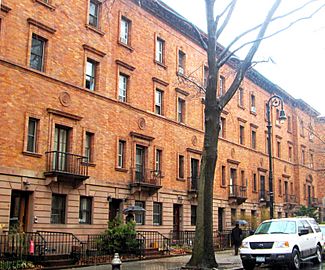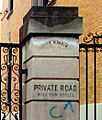St. Nicholas Historic District facts for kids
|
St. Nicholas Historic District
("Striver's Row") |
|

Row houses by Stanford White on West 139th Street (2014)
|
|
| Location | W. 138th and W. 139th Sts. (both sides) btwn. Adam Clayton Powell Jr. & Frederick Douglass Blvds. Manhattan, New York City |
|---|---|
| Area | 9.9 acres (4.0 ha) |
| Built | 1891–93 |
| Architect | James Brown Lord (W.138/south) Bruce Price and Clarence S. Luce (W.138/north & W.139/south) Stanford White of McKim, Mead & White (W.139/north). |
| Architectural style | Georgian Revival Colonial Revival Italian Renaissance Revival |
| NRHP reference No. | 75001209 |
Quick facts for kids Significant dates |
|
| Added to NRHP | October 29, 1975 |

The St. Nicholas Historic District is a special area in Harlem, New York City. People often call it "Striver's Row". It's located on West 138th and West 139th Streets, between Adam Clayton Powell Jr. Boulevard and Frederick Douglass Boulevard.
This district is famous for its beautiful row houses. These homes were built between 1891 and 1893. They were designed by three different groups of architects. The area is known as a great example of city design from the late 1800s.
The houses are divided into three main styles:
- Some houses on West 138th Street are made of red brick and brownstone. They were designed by James Brown Lord in the Georgian Revival style.
- Other houses on West 138th and West 139th Streets are yellow brick with white limestone and terra cotta. These were designed by Bruce Price and Clarence S. Luce in the Colonial Revival style.
- The houses on the north side of West 139th Street are dark brick, brownstone, and terra cotta. They were designed by Stanford White in the Italian Renaissance Revival style.
The St. Nicholas Historic District became a New York City landmark in 1967. It was added to the National Register of Historic Places in 1975. The name "St. Nicholas" comes from the nearby St. Nicholas Park.
Contents
The Story of Striver's Row
Building a New Neighborhood
A builder named David H. King, Jr. created what we now call "Striver's Row". He had built many famous structures before, like the base of the Statue of Liberty. King wanted to create a special neighborhood for wealthy families.
He called his new project the "King Model Houses". These homes had modern features and beautiful wood inside. They also offered nice views of City College. King hoped to build a unique area that would stand out from its surroundings.
Hidden Alleys and Horse Signs
The houses in Striver's Row are built back-to-back. This design allowed King to include shared courtyards in the back. There are also special alleyways between the houses. These alleys are rare in Manhattan.
Some of the gates to these alleys still have old signs that say "Walk Your Horses". Long ago, these alleys were used for keeping horses and delivering supplies quietly. Today, people mostly use the back areas for parking their cars.
From Empty Homes to "Strivers"
At first, King didn't sell many of the houses. A company that helped pay for the project took over most of them in 1895. Around this time, many white New Yorkers were moving out of Harlem.
For a while, the company would not sell the houses to African American families. So, the homes stayed empty until 1919–1920. Finally, they became available to African Americans for about $8,000 each.
Many leaders and successful professionals from the Black community moved into these homes. These "strivers" gave the district its famous nickname. Living on "Striver's Row" meant you had achieved success.
Changes Over Time
By the 1940s, some of the houses began to show their age. Many were divided into smaller rooms for rent. This meant that some of the original decorations inside the homes were lost. However, the outside of the houses usually stayed the same.
After 1995, Harlem's real estate market grew. Many of these historic buildings are now being restored. They are being brought back to look more like they did when they were first built.
Images for kids





